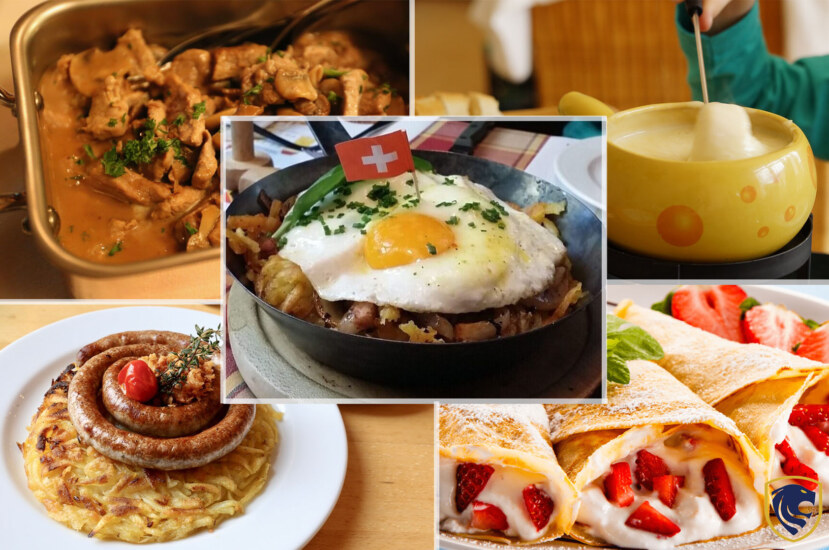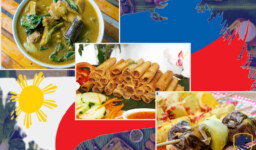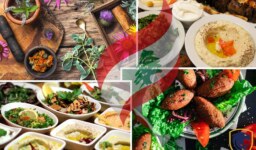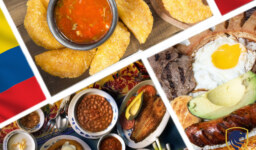You may know Switzerland for its breathtaking landscapes. But, it is not the only part of Switzerland that can mesmerize you. A complex and varied fusion of regional specialties and foreign influences can be found in Swiss cuisine. It is distinguished by the use of seasonal, fresh ingredients and a concentration on filling, substantial meals that can withstand the chilly Alpine environment. Rosti, fondue, raclette, and various kinds of sausage, such as bratwurst and cervelat, are typical Swiss fare. In keeping with the nation’s geographical location at the crossroads of Europe, Swiss cuisine also combines characteristics of French, Italian, and German food. Swiss cheese and chocolate are well known for their superior quality and unique tastes worldwide. All things considered, Swiss food is a delectable and fulfilling symbol of the nation’s rich cultural past.
Bircher Müesli
Bircher müesli is the name of a well-known Swiss breakfast consisting of oat flakes soaked in a mixture. This mixture contains milk and yogurt and is then served with honey, hazelnuts, and apples. It originated in the early 1900s by Swiss doctor Maximilian Oskar Bircher-Brenner.
The lengthy resting period for the oats is essential to this well-known Swiss meal. The oats require at least two hours to rest thoroughly. But overnight is ideal for the creamiest outcome. To allow the raw oats time to break down and release their starches, soaking them overnight is also customary in Switzerland. Moreover, before soaking, you should also add shredded apples to make bircher müesli, which is the most traditional variation.

Best Traditional Food To Try In Switzerland; Bircher Müesli
Various nuts, most frequently hazelnuts, raisins, and honey are typical toppings that are used in this meal. The Swiss advise soaking your morning oats in cream if you’d prefer them creamier. You will need to add it after soaking since doing so will make them exceedingly rich but without the yogurt’s distinctive tang. This delicious Swiss breakfast dish is frequently found in hotel breakfast bars, cafés, and Swiss households throughout Switzerland.
Fondue
Switzerland’s national cuisine, fondue, is a melting pot of many flavors and fragrances, much like the nation itself. It is a melting pot of people and cultures. It was initially mentioned in Homer’s Iliad as a combination of goat cheese, flour, and wine. Also, its name is derived from the French term fondre, which means to melt.
The main component of fondue is a cheese that is melted over a fire, along with a variety of regional variations and flavorings like cherry brandy, white wine, or a dash of nutmeg. It was created out of necessity when residents and wandering herders in the mountains were unable to survive the winter on anything other than cheese, wine, and bread.

Best Traditional Food To Try In Switzerland; Fondue
During the winter, people began to melt cheese with wine and dip pieces of old bread into it as the summer cheese began to dry up and the bread turned stale. Traditionally, fondue is made in a caquelon, which is a flameproof dish.
The recipe varies depending on the region. Fondue Fribourg is made with ripe Vacherin cheese. Also, fondue Vandois with Gruyére and Emmental, and fondue Neuchatel with Gruyére and Emmental. Traditional fondue forks with long handles are used to twirl pieces of bread in cheese. A round of beverages must be purchased for everyone participating in this peculiar and cheesy community activity whenever someone loses a slice of bread in the pot, per the local custom.
Rösti
In this classic Swiss meal known as rösti, shredded potatoes are fried until they are crisp on the exterior and delicate on the inside. This traditional Swiss meal is frequently served as part of breakfast or brunch. But it can also be eaten as a side dish or as a main entrée.
Rösti was a common breakfast item for farmers in the 19th century in the German-speaking areas of Switzerland. Later, it was embraced by the general populace and was named Switzerland’s national dish. The basic components for rösti are shredded potatoes, salt, and occasionally other items like cheese or onions. The mixture is then cooked till golden brown in a skillet with butter or oil.

Best Traditional Food To Try In Switzerland; Rösti
Rösti is frequently served with traditional Swiss foods like fried eggs or veggies. In addition, it can be served with sausages, bacon, or cheese. With the inclusion of mushrooms or other vegetables, it is also occasionally served as a vegetarian meal.
Outside of Switzerland, rösti has gained popularity. So, it is now available throughout most of Europe and North America. It is a delicious, adaptable, tasty recipe and a fantastic way to use leftover potatoes. Rösti is a delightful and filling meal that is perfect as a side dish with supper or as part of a typical Swiss breakfast.
Marroni
The distinct fragrance of chestnuts roasting over a fire in front of the vibrant street vendors that are frequently located in squares and on street corners will be detectable if you are in Switzerland in the fall or winter. The Swiss refer to this dish as marron. They are among Switzerland’s popular winter cuisine customs, along with raclette and fondue.
In meals from Ticino, chestnuts are a frequent element in food. Large chestnut woods may be found in the Ticino region. There you can go chestnut foraging. These may be used to produce sweet and savory recipes by roasting, or cooking.

Best Traditional Food To Try In Switzerland; Marroni
A common street food is roasted chestnuts, which are often served in paper cones that you hold in your hand. Since the winters in Switzerland are chilly, they also serve as hand warmers. The process of roasting chestnuts at home is very easy. But the ones you buy on the street are typically completely charred from the fire.
It’s important to wrap your still-hot chestnuts firmly in a newspaper for a few minutes after they’re finished cooking to let them sweat out. So, they peel with ease. You may enjoy them warm with a mug of mulled wine or another hot winter beverage once they have had a chance to cool down a bit.
Zopf
The ingredients for zopf, a classic Swiss bread, are wheat, butter, yeast, milk, and eggs. It resembles the Jewish bread challah in form and feels, being soft and braided. Zopf is typically made throughout the weekend and eaten on Sundays. Usually, it is eaten with butter and jam.

Best Traditional Food To Try In Switzerland; Zopf
The bread is said to have been created in the middle of the 15th century. Widows used to chop off their braided hair and inter it alongside their deceased spouses in the past. Later, instead of burying hair, they cooked zopf and placed bread in the grave. There is a literal translation of the word “zopf” into the English language, which means “braid,” in reference to the bread’s form.
Landjäger
It is common to munch on Landjäger, a traditional dried sausage from Switzerland, while hiking or as a quick and easy source of protein. A mixture of beef and pork is used to make the sausage. Then put into a casing and smoked after being spiced with ingredients like garlic, coriander, and paprika.
The sausage was initially created as a snack for hunters and other outdoor enthusiasts who needed a robust and transportable source of protein. The term “Landjäger” translates to “land hunter” in German. People from many walks of life now enjoy Landjäger, which is sold in several specialized food stores and marketplaces throughout Switzerland.

Best Traditional Food To Try In Switzerland; Landjäger
Other dried sausage varieties cannot compare to the flavor and texture of landjäger. It has a chewy, somewhat salty flavor that comes from smoking. In addition, it has a smoky flavor. The sausage is frequently thinly sliced and eaten as a snack on its own or with cheese, bread, and other fixings.
Known as one of the most important elements of Swiss cuisine, landjäger plays a significant role in the culture of the nation. The ability to produce a tasty and wholesome diet that can be consumed at home or on the road is a monument to the creativity and inventiveness of the Swiss people.




